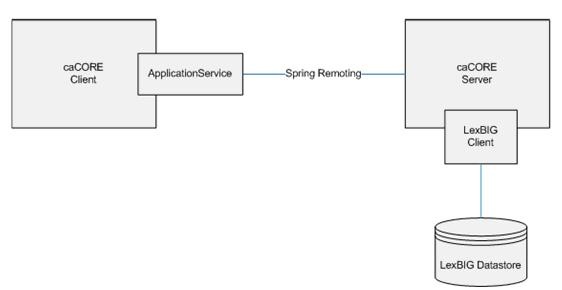 |
Page History
...
| Info | ||
|---|---|---|
| ||
You cannot integrate caCORE 3.2 components with caCORE LexEVS 6.x. If you used multiple components of caCORE 3.2 (for example, EVS with caDSR), you need to continue to work with the caCORE 3.2 release until the other caCORE 4.0 components are available. |
The LexEVS object model was developed by the Mayo Clinic. In its native form, the associated API assumes a local, non-distributed means of access. With caCORE LexEVS 6.x, a proxy layer enables EVS API clients to access the native LexEVS API from anywhere without having to worry about the underlying data sources. This is called the Distributed LexEVS (DLB) API.
The DLB Adapter is another option for caCORE LexEVS 6.x clients who choose to interface directly with the LexEVS API. This is essentially a set of convenience methods intended to simplify the use of the LexEVS API. For example, a series of method calls against the DLB API might equate to a single method call to the DLB Adapter.
| Info | ||
|---|---|---|
| ||
The DLB Adapter is not intended to represent a complete set of convenience methods. As part of the caCORE LexEVS 6.x release, the intention is that users will work with the DLB API and suggest useful methods of convenience to the EVS Development Team. |
LexEVS Data Sources
The LexEVS data source is the open source LexEVS terminology server. EVS clients interface with the LexEVS API to retrieve desired vocabulary data. The EVS provides the NCI with services and resources for controlled biomedical vocabularies, including the NCI Thesaurus and the NCI Metathesaurus.
NCI Thesaurus
The NCI Thesaurus is composed of over 27,000 concepts represented by about 78,000 terms. The Thesaurus is organized into 18 hierarchical trees covering areas such as Neoplasms, Drugs, Anatomy, Genes, Proteins, and Techniques. These terms are deployed by the NCI in its automated systems for uses such as key wording and database coding.
NCI Metathesaurus
The NCI Metathesaurus maps terms from one standard vocabulary to another, facilitating collaboration, data sharing, and data pooling for clinical trials and scientific databases. The Metathesaurus is based on the Unified Medical Language System (UMLS) developed by the National Library of Medicine (NLM). It is composed of over 70 biomedical vocabulariescalled Distributed LexEVS API enables Distributed API clients to access the LexEVS API from anywhere.
Interfaces
Main interfaces included in the LexEVSAPI package.
LexEVSService
The Main LexEVSAPI Interface. JavaDoc
LexEVSDistributed
The Distributed LexEVS Portion of LexEVSAPI. This interface is a framework for calling LexEVS API methods remotely, along with enforcing security measures. JavaDoc
| Add Page | ||||||
|---|---|---|---|---|---|---|
|
LexEVSDataService
| Warning | ||
|---|---|---|
|
...
| |
See the CTS2 API for REST Services |
...
The caCORE-SDK Data Service Portion of LexEVSAPI. This extends on the caCORE ApplicationService to provide additional Query Options. JavaDoc
LexEVSService
The Main LexEVSAPI Interface. This includes support for caCORE-SDK Data Service calls as well as remote LexBIG API callsdirect to database query options. JavaDoc
Search Paradigm
The caCORE LexEVS architecture includes a service layer that provides a single, common access paradigm to clients that use any of the provided interfaces. As an object-oriented middleware layer designed for flexible data access, caCORE LexEVS relies heavily on strongly typed objects and an object-in/object-out mechanism.
...
| Info | ||
|---|---|---|
| ||
When specifying attribute values in the query string, note that use of the following characters generates an error: |
Distributed LexEVS API
| Info | ||
|---|---|---|
| ||
| Distributed LexEVS API |
...
Since in many cases the objects returned from the LexBIGService are not merely beans, but full-fledged data access objects (DAOs), the caCORE LexEVS client is configured to proxy method calls into the LexEVS objects and forward them to the caCORE server so that they execute within the LexEVS environment. The following figure shows the DLB architecture (caCORE => Application Service === Spring Remoting === caCORE Server => LexBIG Client = >LexBIG Datastore).
The DLB The Distributed LexEVS API environment will be configured on the caCORE LexEVS Server (http://lexevsapi60.nci.nih.gov/lexevsapi60). This will give the server access to the LexEVS database and other resources. The client must therefore go through the caCORE LexEVS server to access any LexEVS data.
...
